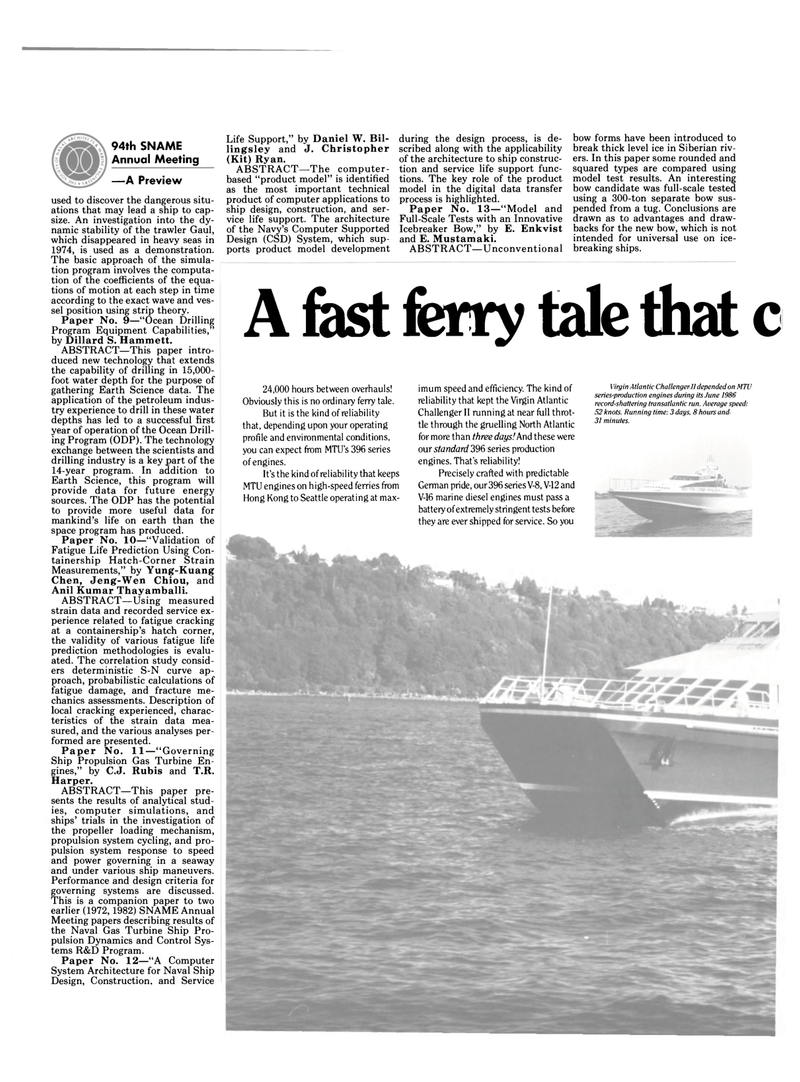
Page 28: of Maritime Reporter Magazine (November 1986)
Read this page in Pdf, Flash or Html5 edition of November 1986 Maritime Reporter Magazine
94th SNAME
Annual Meeting —A Preview used to discover the dangerous situ- ations that may lead a ship to cap- size. An investigation into the dy- namic stability of the trawler Gaul, which disappeared in heavy seas in 1974, is used as a demonstration.
The basic approach of the simula- tion program involves the computa- tion of the coefficients of the equa- tions of motion at each step in time according to the exact wave and ves- sel position using strip theory.
Paper No. 9—"Ocean Drilling
Program Equipment Capabilities," by Dillard S. Hammett.
ABSTRACT—This paper intro- duced new technology that extends the capability of drilling in 15,000- foot water depth for the purpose of gathering Earth Science data. The application of the petroleum indus- try experience to drill in these water depths has led to a successful first year of operation of the Ocean Drill- ing Program (ODP). The technology exchange between the scientists and drilling industry is a key part of the 14-year program. In addition to
Earth Science, this program will provide data for future energy sources. The ODP has the potential to provide more useful data for mankind's life on earth than the space program has produced.
Paper No. 10—"Validation of
Fatigue Life Prediction Using Con- tainership Hatch-Corner Strain
Measurements," by Yung-Kuang
Chen, Jeng-Wen Chiou, and
Anil Kumar Thayamballi.
ABSTRACT—Using measured strain data and recorded service ex- perience related to fatigue cracking at a containership's hatch corner, the validity of various fatigue life prediction methodologies is evalu- ated. The correlation study consid- ers deterministic S-N curve ap- proach, probabilistic calculations of fatigue damage, and fracture me- chanics assessments. Description of local cracking experienced, charac- teristics of the strain data mea- sured, and the various analyses per- formed are presented.
Paper No. 11—"Governing
Ship Propulsion Gas Turbine En- gines," by C.J. Rubis and T.R.
Harper.
ABSTRACT—This paper pre- sents the results of analytical stud- ies, computer simulations, and ships' trials in the investigation of the propeller loading mechanism, propulsion system cycling, and pro- pulsion system response to speed and power governing in a seaway and under various ship maneuvers.
Performance and design criteria for governing systems are discussed.
This is a companion paper to two earlier (1972,1982) SNAME Annual
Meeting papers describing results of the Naval Gas Turbine Ship Pro- pulsion Dynamics and Control Sys- tems R&D Program.
Paper No. 12—"A Computer
System Architecture for Naval Ship
Design, Construction, and Service
Life Support," by Daniel W. Bil- lingsley and J. Christopher (Kit) Ryan.
ABSTRACT—The computer- based "product model" is identified as the most important technical product of computer applications to ship design, construction, and ser- vice life support. The architecture of the Navy's Computer Supported
Design (CSD) System, which sup- ports product model development during the design process, is de- scribed along with the applicability of the architecture to ship construc- tion and service life support func- tions. The key role of the product model in the digital data transfer process is highlighted.
Paper No. 13—"Model and
Full-Scale Tests with an Innovative
Icebreaker Bow," by E. Enkvist and E. Mustamaki.
ABSTRACT—Unconventional bow forms have been introduced to break thick level ice in Siberian riv- ers. In this paper some rounded and squared types are compared using model test results. An interesting bow candidate was full-scale tested using a 300-ton separate bow sus- pended from a tug. Conclusions are drawn as to advantages and draw- backs for the new bow, which is not intended for universal use on ice- breaking ships.
A fast ferry tak that c 24,000 hours between overhauls!
Obviously this is no ordinary ferry tale.
But it is the kind of reliability that, depending upon your operating profile and environmental conditions, you can expect from MTU's 396 series of engines.
It's the kind of reliability that keeps
MTU engines on high-speed ferries from
Hong Kong to Seattle operating at max- imum speed and efficiency. The kind of reliability that kept the Virgin Atlantic
Challenger II running at near full throt- tle through the gruelling North Atlantic for more than three days! And these were our standard 396 series production engines. That's reliability!
Precisely crafted with predictable
German pride, our 396 series V-8, V-12 and
V-16 marine diesel engines must pass a battery of extremely stringent tests before they are ever shipped for service. So you
Virgin Atlantic Challenger 11 depended on MTU series-production engines during its June 1986 record-shattering transatlantic run. Average speed: 52 knots. Running time: 3 days. 8 hours and 31 minutes.

 27
27

 29
29
